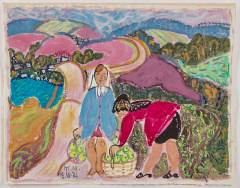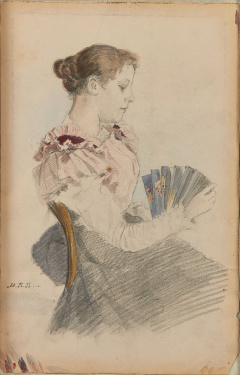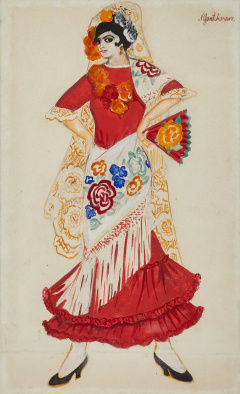Art Investment
Lapshin Nikolay Fedorovich
1891–1942
БИОГРАФИЯ
LAPSHIN Nikolay Fedorovich
Painter, graphic artist, master of decorative and applied arts, scene-designer
Nikolay Lapshin was born to a merchant family. Since 1900 Lapshin attended elementary school under the Central School of Technical Drawing of Baron Alexander Stieglitz. Later he studied at the non-classical secondary school. In 1911 Lapshin entered the faculty of economics at the Polytechnic school in St. Petersburg. At the same time he continued his art education, studied in the Drawing school under the Society for the Encouragement of the Arts (OPKh) under the guidance of N. P. Khimona and I. Y. Bilibin (1911–1912), later — in the private studios of Y. F. Tsionglinsky (1912) and M. D. Bernshtein (1913–1915).
In 1911–1912 Lapshin attended lectures of the professor N. V. Pokrovsky in the Archaeological Institute; he also was interested in art of Old Russia and paintings by Albert Marquet, which he had seen at the exhibition Hundred Years of French Art in St. Petersburg.
Since 1914 Lapshin participated in exhibitions of art; he exhibited his works at the exhibition No. 4. Futurists. Rayonists. Primitive in Moscow. He created design for the cinema Anons in Petrograd (1915).
In 1915 Lapshin was called up for military service; he served in Galicia. In 1916 he was contused and wound in the leg, and then he was evacuated to Petrograd. Lapshin took part in publication of the futuristic magazine Beskrovnoye Ubiystvo (“Bloodless Murder”), he designed no. 14 and no. 15. Lapshin was transferred as an artist and stage designer to the Grenadier Regiment, where he created sketches for travelling performances. Lapshin together with V. M. Ermolaeva designed the production of the play Yanko Krul Albansky by I. M. Zdanevich. The artist joined the Art and Literature Circle Kvartira No. 5 (“Apartment No. 5”), which members gathered together in the apartment of the curator of the Museum at the Academy of Fine Arts.
In 1917–1918 Lapshin participated in decoration of Petrograd for the opening day of the Constituent Assembly, and for the first anniversary of the October revolution.
At the same time he served in the non-combatant reserve infantry regiment no. 171; in 1918 he was demobilized. Lapshin worked in the publishing department of the State Free Art Studios in Petrograd. In 1918–1921 he created a series of cubistic watercolours Petrograd. Lapshin together with A. A. Uspensky taught drawing at the art school of Moscow–Narvsky district of Petrograd. Since 1921 he was a professor of decorative painting at the Higher State Artistic and Technical Workshops (VKhUTEMAS). In 1921–1923 Lapshin worked in the studio of painting under the State Porcelain Factory; he created a lot of designs for tea and coffee services, including the service White with Pink, which won gold medal at the International Exposition of Modern Industrial and Decorative Arts in Paris.
In 1921–1924 Lapshin worked for the Museum of Artistic Culture. In 1922 the artist joined the Society of new tendencies in art headed by V. E. Tatlin. In 1923 Lapshin settled in the apartment on the embankment of the Moyka River. He painted a lot of views from the windows of this apartment in 1930s–1940s.
In 1924 Lapshin was sent on a mission abroad; he visited Reval, Riga, Berlin and Prague. In 1924–1925 he was a member of the Society of Individualist Artists. In 1925–1928 he executed a lot of views of Prague, Leningrad, Pavlovsk, Peterhof, and Oranienbaum for postcards. In 1927 Lapshin took part in the 3rd International Decorative Art Exhibition Milan–Monza in Milan, in 1928 — in the exhibition of the society Four Arts in Leningrad. In 1932 Lapshin became a member of Leningrad Union of Artists of the RSFSR (LOSKh): since 1939 he was a board member of the Union. Lapshin together wih Uspensky was engaged in decotation of the city of Leningrad for the 15th anniversary of the October revolution. In 1933 the artist began to work in lithography. In 1934–1935 he worked as an industrial designer at the Leningrad Lomonosov Porcelain Factory. In 1935 Lapshin took part in the First Exhibition of Leningrad Artists at the State Russian Museum. In 1936 he created scene and costume design for the performances The Little Tragedies and Floridsdorf at the Gorky Bolshoi Drama Theatre. In 1936 Lapshin together with A. S. Vedernikov made a trip along the Volga and Kama Rivers; in 1937 he visited Karelia.
The artist was also engaged in teaching. Since 1926 Lapshin delivered lectures at the Institute of Art History; in 1929–1933 he taught graphic art and printing at the Polygraphic Technical School, in 1931–1933 — drawing at the Engineering College under Leningrad Institute of Industrial Engineering, in 1933–1937 — painting and drawing at the faculty of architecture at the Institute of Painting, Sculpture and Architecture under the All-Russia Academy of Art, in 1933–1940 — painting and drawing at Leningrad Institute of Communal Construction; since 1935 he headed the workshop of painting at Leningrad House of Architect.
In 1920–1930s the artist worked a lot in book and magazine graphic art. Lapshin worked for the magazines Mukhomor (“Amanita”; 1922–1923), Zhizn Iskusstva (“Life of Art”; 1922–1930), Oras (1923–1926), Begemot (“Hippopotamus”; 1924), Kostyor (“Fire”; 1936) and others. In 1928–1931 he was an art director of the ChIZh (“Extremely Interesting Magazine” or “Siskin”) and YeZh (“Monthly Magazine” or “Hedgehog”) children’s magazines. Since 1925 Lapshin collaborated with the department of children’s and youthful literature at the State Publishing House (Gosizdat). The artist designed many books, including Watch by E. G. Polonskaya (1926); Baloon by B. S. Zhitkov (1926); Devil by M. Zoshchenko (1928); Wonderful Holiday by N. M. Oleynikov (1928); Chinese Secret by E. Y. Dan’ko (1929); The Travels of Marko Polo (1933; Lapshin was awarded the first prize at the contest by the publishing house The Limited Edition Club in New York); The Golden Pot by E.T.A. Hoffmann (1936; for the The Limited Edition Club); Japanese Folk-tales (1936); The Little Tragedies (1936), The Stone Guest and The Miserly Knight (1937) by A. S. Pushkin for the publishing house Khudozhestvennaya Literatura (“Belletristic Literature”). Lapshin created a series of illustrations for the popular science books by M. Iliyn.
The artist took part in many group exhibitions. He exhibited his works at the International exhibition Art of the Book at the Museum of Fine Arts in Leipzig (1927), the exhibition Artists of the RSFSR for 15 years at the State Museum of Fine Arts (1932), the exhibition of Soviet graphic art at the gallery Bloomsbury in London (1934), the exhibition of autolithography by Leningrad artists in Leningrad and many others.
Nikolay Lapshin died in 1942 during the Leningrad Blockade.
Nikolay Lapshin belongs to a group of the artists (N. A. Tyrsa, Lapshin, Uspensky, Vedernikov) traditionally called the Leningrad landscape school. His early works were close to cubism and futurism. In the mid-1920s, under the influence of Albert Marquet, Lapshin developed his own recognisable style. In his easel works Lapshin depicted not so mush detailed reproduction of nature as impression after states of nature and mood. Landscapes by Lapshin are characterized by subtle colour nuances, show through of paint coats. Due to this effect, the artist achieved airiness and lightness in his works even painted in oil. Watercolour was favourite technique of the artist. Lapshin made a valuable contribution to book art and to decorative and applied arts.
The artist left great artistic legacy: paintings, drawings (series of watercolours), lithographs, linocuts, book and magazine graphic art (design for more than 70 books); he also drew sketches for cards and porcelain.
Works by Nikolay Lapshin are in many museum collections, including the State Tretyakov Gallery, the State Russian Museum, the Pushkin State Museum of Fine Arts and others.
Новости - Auctions
Торги «Антиквариума» 28 июля. Краткие итоги
03.08.2018Очередной аукцион #всёпорублю в «Литфонде» принес почти 4,5 млн.руб.
25.07.2018«Русская Эмаль» торжественно закрывает сезон и уходит в отпуск
24.07.2018Краткие итоги сороковых живописных торгов «Кабинета»
16.07.2018Коротко о главном: итоги аукциона 28 июня в «Литфонде»
03.07.2018Торги 27 июня в «Литфонде» для самых терпеливых и настойчивых
03.07.2018
Услуги ARTinvestment
Арт-консалтинг
Индивидуальные консультации от опытных искусствоведов по любым вопросам в сфере искусства
Составление Инвестиционного Портфеля
Подбор предметов искусства для инвестирования под любую инвестиционную стратегию
Индивидуальная оценка
Наши эксперты проведут профессиональную оценку вашего предмета искусства, учитывая его состояние, авторство, историю и другие факторы
Проведенных аукционов
Зарегистрированных пользователей на аукционе
Записей в базе
Художников в базе
Auction sale in AI Auction

МАВРИНА Татьяна Алексеевна (1900‒1996) Урожайный год на яблоки. 1971 (34 × 44,7 см)
сделать ставку
КУСТОДИЕВ Борис Михайлович (1878–1927) Портрет М. П. П-ой (24,5 × 15,7 см в свету)
сделать ставку
ГОНЧАРОВА Наталия Сергеевна (1881‒1962) Испанка с веером. Вторая половина 1910-х (41 × 25)
сделать ставку